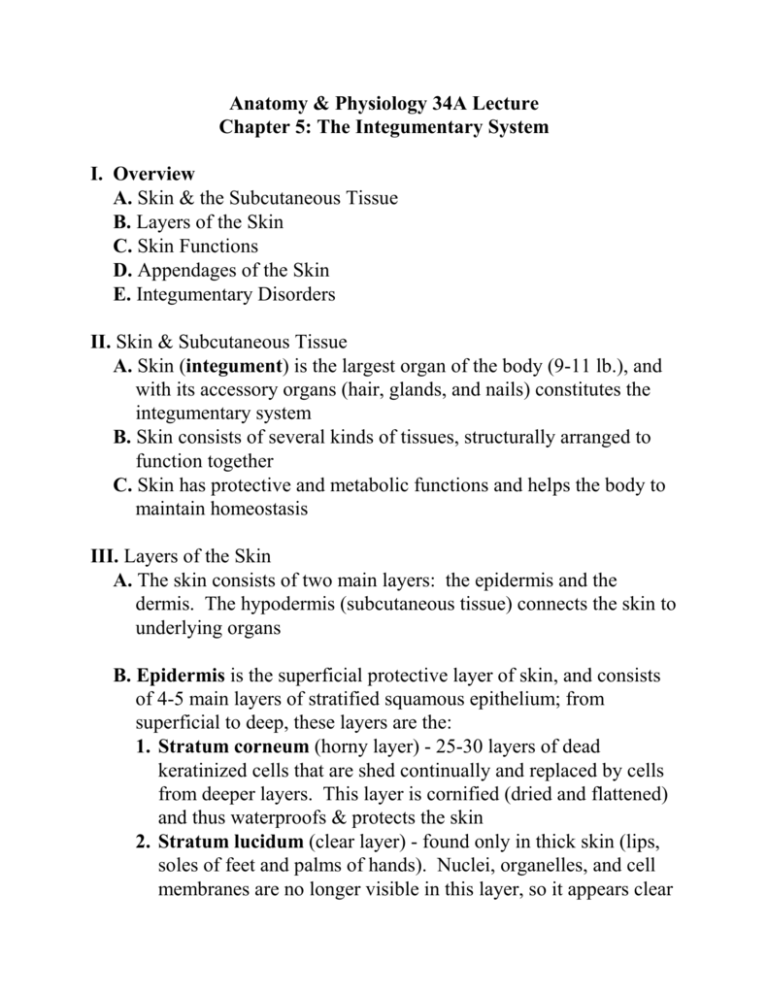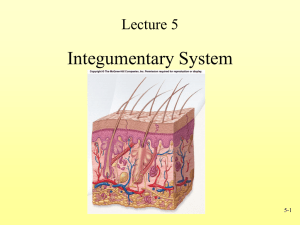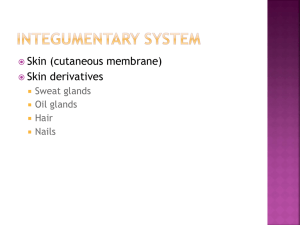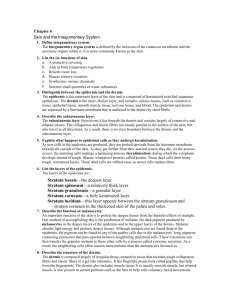Integumentary System - complete outline
advertisement

Anatomy & Physiology 34A Lecture Chapter 5: The Integumentary System I. Overview A. Skin & the Subcutaneous Tissue B. Layers of the Skin C. Skin Functions D. Appendages of the Skin E. Integumentary Disorders II. Skin & Subcutaneous Tissue A. Skin (integument) is the largest organ of the body (9-11 lb.), and with its accessory organs (hair, glands, and nails) constitutes the integumentary system B. Skin consists of several kinds of tissues, structurally arranged to function together C. Skin has protective and metabolic functions and helps the body to maintain homeostasis III. Layers of the Skin A. The skin consists of two main layers: the epidermis and the dermis. The hypodermis (subcutaneous tissue) connects the skin to underlying organs B. Epidermis is the superficial protective layer of skin, and consists of 4-5 main layers of stratified squamous epithelium; from superficial to deep, these layers are the: 1. Stratum corneum (horny layer) - 25-30 layers of dead keratinized cells that are shed continually and replaced by cells from deeper layers. This layer is cornified (dried and flattened) and thus waterproofs & protects the skin 2. Stratum lucidum (clear layer) - found only in thick skin (lips, soles of feet and palms of hands). Nuclei, organelles, and cell membranes are no longer visible in this layer, so it appears clear 2 3. Stratum granulosum (granular layer) - 3-5 flattened rows of keratinocytes that contain granules filled with keratohyalin, a precursor to keratin, and lamellated granules that produce water proofing glycolipids 4. Stratum spinosum (spiny layer) - several stratified layers of cells that have spine like extensions from the keratinocytes. a. Langerhans cells (dendritic cells) - protective macrophagic cells that ingest bacteria and other foreign debris are found here b. Some mitosis occurs in this layer 5. Stratum basale (germinating layer) - single layer of cuboidal cells attached to the underlying dermis. Most mitosis occurs here. Three types of cells compose this layer: a. Keratinocytes - produce keratin, which toughens and waterproofs the skin, as well as antibiotics & enzymes b. Melanocytes - epithelial cells that synthesize melanin skin pigment, which provides protection against UV radiation c. Merkel (Tactile) cells - a few sensory protective cells that aid in touch reception C. Dermis (hide) - deeper and thicker than the epidermis; has two layers: 1. Papillary layer - upper layer in contact with the epidermis; characteristics include: a. Consists of areolar connective tissue b. Has dermal papilla that extend into the epidermis; these papilla form fingerprint ridges of finger tips and toes c. Some dermal papilla contain Meissner’s corpuscles that are sensitive to touch 2. Reticular layer - deeper portion of the dermis that consists of dense irregular CT with interlaced collagen fibers and contains many blood vessels, nerves, hair follicles, arrector pili, pressure receptors (Pacinian corpuscles), sweat (sudoriferous) and sebaceous glands 3 D. Hypodermis (subcutaneous layer or superficial fascia) - not part of the skin; binds the dermis to underlying organs 1. Composed primarily of areolar CT and adipose tissue interlaced with blood vessels 2. Amount of adipose tissue varies with the body region, age, sex, and nutrition of the individual 3. Collagen and elastic fibers reinforce the hypodermis, especially on the palms and soles of feet 4. Hypodermis is the site for subcutaneous injections E. Skin Color is due primarily to three pigments: heme, melanin, and carotene 1. Heme – red blood pigment in hemoglobin, combined with white dermal collagen fibers produces Caucasian skin color 2. Melanin in the stratum basal and spinosum produces brown, black, tan, yellowish, and reddish skin hues. UV radiation stimulates melanocytes to increase melanin production (suntan) 3. Carotene – yellow pigment acquired from egg yolks and yellow and orange vegetables 4. Abnormal skin colors include a. Cyanosis – bluish color due to deficiency of oxygen in blood b. Erythemia – abnormal redness of skin due to dilated cutaneous blood vessels c. Jaundice – yellowish skin due to high levels of bilirubin in blood. Often caused by liver damage from cirrohosis, hepatitis, or cancer d. Bronzing – tan color resulting from Addison disease e. Pallor – pale or ashen color due to reduced blood flow through the skin resulting from shock, low BP, cold, or anemia f. Albinism – pale skin, white hair, pink eyes due to genetics g. Hematoma (bruise) – mass of clotted blood showing through the skin; due to trauma, hemophilia, metabolic disorders 4 IV. Skin Functions 1. Physical protection - provides a barrier to microorganisms, water, and UV radiation 2. Hydroregulation - the thick, keratinized, cornified, dead cells of the epidermis are virtually waterproof, protecting the body from dessication (drying out) 3. Thermoregulation - normal body temperature of 37C (98.6F) is maintained in 3 ways by the skin: a. Cools body via dilated cutaneous blood vessels b. Evaporation of perspiration c. Retention of heat from constricted cutaneous blood vessels 4. Cutaneous absorption (through the skin) is limited by protective skin barriers, but UV light, lipid soluble toxins, and gases, such as oxygen and CO2, can pass through the skin 5. Synthesis of melanin, keratin and vitamin D a. Melanin and keratin remain in the skin b. Vitamin D is synthesized by skin exposed to small amounts of UV light 1) A cholesterol derivative is modified in the liver and kidneys to produce calcitriol (vit. D), which enters the blood and helps to regulate the metabolism of calcium and phosphorous for strong bones 2) Vit. D deficiency leads to rickets 6. Sensory Reception via cutaneous receptors in the dermis respond to heat, cold, pressure, touch, vibration, and pain; especially abundant in the face, palms, fingers, soles of feet, and genitals V. Skin Appendages are derived from the epidermis and extend into the dermis; include hair, nails, and integumentary glands A. Hair is found mainly on the scalp, face, pubis, and axillae; its primary function is protection; each hair consists of a shaft, root, and bulb 5 1. The shaft is the visible, dead part of hair extending above the skin surface 2. The bulb is the enlarged base of the root within the hair follicle (a sheath of epithelium & CT) a. Each hair develops from stratum basale cells within the hair bulb, where nutrients are received from dermal blood vessels b. As the cells divide, they are pushed toward the surface and cellular death and keritinization occurs c. Sebaceous glands and arrector pili muscles are attached to the hair follicle. Arrector pili muscles are involuntary and contract in response to cold or fear, causing “goose bumps” 3. In cross section, a hair has 3 layers a. Medulla- central core of loosely arranged cells and air spaces b. Cuticle – outer single layer of scale-like cells c. Cortex – middle layer of densely packed keratinized cells. 4. Hair color is due to melanin produced by melanocytes in the bulb and transferred to cells in the cortex. B. Nails on finger and toe tips are formed from the stratum corneum of the epidermis 1. Each nail consists of a body, free border, and hidden border 2. The body rests on a nail bed (stratum spinosum) 3. The sides of the nail are protected by a nail fold, and the furrow between the sides and body is the nail groove 4. The free border of the nail extends over a thickened region of the stratum corneum called the hypochonium 5. Eponychium (cuticle) is dead epidermis that covers the proximal end of the nail 6. The root of the nail is attached at the base 7. Abnormal nail conditions can indicate body dysfunction a. Respiratory or thyroid disorders are indicated by yellow nails b. Thick, yellowish nails signal a fungal infection c. Outward concavity can indicate an iron deficiency 6 d. Horizontal lines are a hint of malnutrition 7 C. Glands originate in the epidermis, but extend into the dermis during development. Skin glands are exocrine and are of 3 basic types: sebaceous, sudoriferous, and ceruminous 1. Sebaceous (oil) glands are holocrine glands that secrete sebum onto a hair shaft, where it is dispersed on the hair and to the skin. Blockage of sebaceous gland ducts results in acne 2. Sudoriferous (sweat) glands excrete perspiration onto the skin surface; eccrine and apocrine glands are coiled and tubular a. Eccrine glands - scattered throughout the body (especially forehead, palms, soles), they produce clear perspiration consisting mostly of water, salts, and urea b. Apocrine glands - found in axillary and pubic areas; secrete a milky protein and fat rich substance into hair follicles (analogous to sexual scent glands in animals) c. Ceruminous glands are found only in the external auditory (ear) canal where they secrete cerumin (ear wax) d. Mammary glands - specialized glands in the breasts that secrete milk during lactation (not part of the integument) VI. Integumentary Disorders A. Inflammatory conditions (dermatitis) - infectious skin diseases may be caused by viruses, bacteria, STDs, fungi, and mites B. Neoplasms - include both benign (noncancerous) and malignant (cancerous) skin growths 1. Benign skin growths include: a. Pigmented moles due to growth of melanocytes b. Warts virally caused abnormal growths, usually on hands and feet 2. Malignant skin cancers are mostly of 3 types: a. Basal cell carcinoma - most common type, arises from cells in the stratum basale in areas where skin exposure to sun is great; doesn’t usually metastasize and can be surgically excised 8 b. Squamous cell carcinoma - arises from keratinocytes in the stratum spinosum; may invade the dermis and metastasize; treatment consists of excision and radiation therapy c. Malignant melanoma - most life threatening form, arises from melanocytes in the stratum basale; begins as a small mole that enlarges, changes color bleeds easily, and metastasizes quickly; must be treated early to avoid death d. Warning signs of skin cancer include the ABCDEs A= assymetry B= border is irregular C= colors differ D= diameter is greater than 6 mm E= elevation of mole C. Burns that have a local effect are less serious than those that have a systemic effect, which involves the whole body; systemic effects include dehydration, shock, reduced circulation, and bacterial infections. Burns are classified as first, second, or third degree 1. In first degree burns (e.g.: sunburn), only the epidermal layers are damaged and symptoms such as redness, pain, and edema are local. Surface layers are shed in a few days 2. Second degree burns involve the epidermis and upper dermis; blisters appear and recovery is slow but usually complete 3. Third degree burns destroy the entire thickness of the skin and often some underlying muscle; skin appears waxy or charred; body develops scar tissue and skin grafts are often needed 4. Extent of burn damage is estimate by the rule of nines, in which the body is divided into regions of 9%, to determine treatment with intravenous fluids D. Aging of the Skin 1. As skin ages, it becomes thin, dry and loses elasticity 2. The number of active hair follicles, melanocytes, sweat and sebaceous glands declines 3. Collagenous fibers in the dermis become thicker and adipose tissue in the hypodermis diminishes, making it thinnner 4. Along with loss of elasticity, wrinkling occurs









